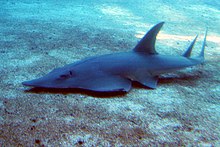Giant guitarfish
| Giant guitarfish | |
|---|---|

| |
| Scientific classification | |
| Kingdom: | |
| Phylum: | |
| Class: | |
| Subclass: | |
| Order: | |
| Family: | Rhinidae
|
| Genus: | |
| Species: | R. djiddensis
|
| Binomial name | |
| Rhynchobatus djiddensis Forsskål, 1775
| |
The giant guitarfish (Rhynchobatus djiddensis), also known as the whitespotted wedgefish, is a large species of guitarfish in the family Rhinidae. It is restricted to the Red Sea, Persian Gulf, and western Indian Ocean,[3] but was formerly considered more widespread due to confusion with its relatives.[1]
Taxonomy and range[]
The giant guitarfish was previously believed to range throughout a large part of the Indo-Pacific, but recent evidence has shown that it, as traditionally defined, actually was a species complex consisting of four different species.[4] In addition to the giant guitarfish, this complex includes the white-spotted guitarfish, the broadnose wedgefish and possibly the smoothnose wedgefish. With these as separate species, the giant guitarfish has a relatively restricted range; it is found only in the Red Sea and Persian Gulf, and the western Indian Ocean as far south as South Africa.[3][5]
Description[]
A large fish reaching up to 3.1 m (10 ft) long and weighing as much as 227 kg (500 lb),[5] it is brownish or greyish above with a variable pattern of white spots. Juveniles have a black spot above each pectoral fin, but in adults it is a dusky ring or absent. There is a dark, bar-like pattern between the eyes (on top of the head), which separates it from the other Rhynchobatus species in its range.[3]
Behavior[]
Breeding[]
It is ovoviviparous, and a female can give birth to litters of up to 10 young.[5][6]
Diet[]
The giant guitarfish feeds on bivalves, crabs, lobsters, squid and small fish.[5][6] Despite not having any cutting teeth, this species is a known predator of stingrays. One specimen from the Philippines had more than 20 stingray barbs stuck in its jaw, apparently unaffected by the stingray's venom.[7]

Habitat[]
It is a shy fish, found at depths of 2–50 m (6.6–164.0 ft), inhabiting areas with a sandy sea floor. These are generally around coastal reefs or reef flats, but they will sometimes venture into the brackish waters of estuaries.[5][6]
Interaction with man[]
The giant guitarfish is harmless to humans. It is listed as critically endangered on the IUCN Red List as its population is believed to have declined significantly due to unregulated high levels of exploitation for its flesh and fins,[4] the latter for shark fin soup. Its low fecundity and presumed slow growth rate make it highly vulnerable to unsustainable exploitation.[4]
| Wikimedia Commons has media related to Rhynchobatus djiddensis. |
| Wikimedia Commons has media related to Rhynchobatus. |
References[]
- ^ a b Kyne, P.M.; Gledhill, K.; Jabado, R.W. (2019). "Rhynchobatus djiddensis". IUCN Red List of Threatened Species. 2019: e.T39394A121035795. doi:10.2305/IUCN.UK.2019-2.RLTS.T39394A121035795.en. Retrieved 18 November 2021.
- ^ "Appendices | CITES". cites.org. Retrieved 2022-01-14.
- ^ a b c Last; White; de Carvalho; Séret; Stehmann; Naylor, eds. (2016). Rays of the World. CSIRO. pp. 68–75. ISBN 9780643109148.
- ^ a b c Kyne, P.M., Gledhill, K. & Jabado, R.W. 2019. Rhynchobatus djiddensis. The IUCN Red List of Threatened Species 2019: e.T39394A121035795. https://doi.org/10.2305/IUCN.UK.2019-2.RLTS.T39394A121035795.en. Downloaded on 26 July 2019.
- ^ a b c d e Froese, Rainer; Pauly, Daniel (eds.) (2007). "Rhynchobatus djiddensis" in FishBase. 7 2007 version.
- ^ a b c Lieske, E. and Myers, R.F. (2004) Coral reef guide; Red Sea London, HarperCollins ISBN 0-00-715986-2
- ^ Pavid, Katie. "The cannibal rays that eat fellow fish". Natural Science Museum.
- IUCN Red List critically endangered species
- Rhynchobatus
- Fish of the Red Sea
- Marine fauna of East Africa
- Taxa named by Peter Forsskål
- Fish described in 1775
